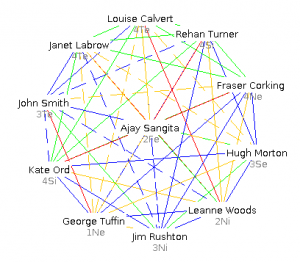
Once two individual's Social Profiles are known, 4G can predict the nature and type of relationships that will develop.
Knowing how individuals process information and their experiences, 4G can forecast the nature or ease of their interactions with others, and, therefore, determine their specific “Social Relationship.”
There are 14 different Social Relationships.
The order of the relationships on the right provides a framework to determine which Social Relationship is more productive than another. This order is also used to calculate Relationship Friction.
Social Relationships also enable us to derive Social Groups, early adopters, cross organizational cohesion and areas for development.
Social Relationships and Colours
As can be seen in the diagram, Social Relationships are shown using different colours. The colours are defined as follows:
- Green: Little or no effort is needed in order to make the relationship productive. The best and most productive relationships.
- Blue: Some effort is needed to make the relationship productive when compared to green relationships but overall, a largely positive relationship.
- Yellow: Significant effort is needed to make the relationship productive.
- Red: Substantial effort is needed to make the relationship productive.
Summary 4G Social Relationships
The following summaries introduce each of the 14 Social Relationships via a one line overview. Further detail, metaphors, coaching tips and recommendations on how to improve specific relationships are outlined in the Visual Team Builder and in the reports available from 4G.
- Action: Immediate common energy and motivation
- Pairs: Identical working style and perceptions
- Balance: Complimentary strengths and weaknesses
- Reflection: Critical mutual feedback readily accepted
- Association: Easy agreement on goals, but can differ on approach to tactics
- Comfort: Work inefficiencies obscured by surface warmth of relationship
- Semi-Balance: Differences beneath the surface emerge from time to time
- Similarity: Apparent differences are overcome with interaction
- O-r-d-e-r: Inherently hierarchical, can be efficient or contentious
- Contrast: Work best one-on-one, but cooperation breaks down with the broader group
- Focus: Struggle to move big ideas to meaningful tactical outcomes
- A-s-s-i-s-t-a-n-c-e: Suggestions offered by more junior relationship partner may or may not be readily accepted
- Interpretation: Apparent agreement hard to reach -- quickly evaporates under scrutiny
- Discovery: Expect easy collaboration and frequently surprised by friction and irritation




